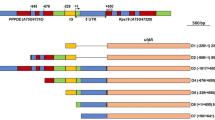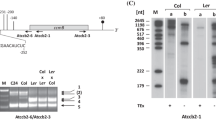Abstract
We have characterized a second nuclear gene (tufM) in Arabidopsis thaliana that encodes a eubacterial-like protein synthesis elongation factor Tu (EF-Tu). This gene does not closely resemble the previously described Arabidopsis nuclear tufA gene, which encodes the plastid EF-Tu, and does not contain sequence elements found in all cyanobacterial and plastid tufA genes. However, the predicted amino acid sequence includes an N-terminal extension which resembles an organellar targeting sequence and shares three unique sequence elements with mitochondrial EF-Tu's, from Saccharomyces cerevisiae and Homo sapiens, suggesting that this gene encodes the Arabidopsis mitochondrial EF-Tu. Consistent with this interpretation, the gene is expressed at a higher level in flowers than in leaves. Phylogenetic analysis confirms the mitochondrial character of the sequence and indicates that the human, yeast, and Arabidopsis tufM genes have undergone considerably more sequence divergence than their cytoplasmic counterparts, perhaps reflecting a cross-compartmental acceleration of gene evolution for components of the mitochondrial translation apparatus. As previously observed for tufA, the tufM gene is present in one copy in Arabidopsis but in several copies in other species of crucifers.
Similar content being viewed by others
References
Aguilar F, Montandon P-E, Stutz E: Two genes encoding the soybean translation elongation factor EF-1α are transcribed in seedling leaves. Plant Mol Biol 17: 351–360 (1991).
An G, Friesen JD: The nucleotide sequence of tufB and four nearby tRNA structural genes of Escherichia coli. Gene 12: 33–39 (1980).
Arumuganathan K, Earle ED: Nuclear DNA content of some important plant species. Plant Mol Biol Rep 9: 208–218 (1991).
Axelos M, Bardet C, Liboz T, LeVan Thai A, Curie C, Lescure B: The gene family encoding the Arabidopsis thaliana translation elongation factor EF-1 alpha: molecular cloning, characterization and expression. Mol Gen Genet 219: 106–12 (1989).
Baldauf SL: Evolutionary transfer of the chloroplast tufA to the nucleus. Doctoral dissertation, The University of Michingan, Ann Arbor, MI (1990).
Baldauf SL, Manhart JR, Palmer JD: Different fates of the chloroplast tufA gene following its transfer to the nucleus in green algae. Proc Natl Acad Sci USA 87: 5317–5321 (1990).
Baldauf SL, Palmer JD: Evolutionary transfer of the chloroplast tufA gene to the nucleus. Nature 344: 262–265 (1990).
Cavalier-Smith T: Kingdom Protozoa and its 18 phyla. Microbiol Rev 57: 953–994 (1993).
Cedergren R, Gray MW, Abel Y, Sankoff D: The evolutionary relationships among known life forms. J Mol Evol 28: 98–112 (1988).
Chaubet N, Chaboute M-E, Philipps G, Gigot C: Histone genes in higher plants: organization and expression. Devel Genet 8: 461–473 (1987).
Chomczynski P, Sacchi N: Single-step method of RNA isolation by acid guanidinium thiocyanate-phenol-chloro-form extraction. Anal Biochem 162: 156–159 (1987).
Delwiche CF, Kuhsel M, Palmer JD: Phylogenetic analysis of tufA sequences indicates a cyanobacterial origin of all plastids. Mol Phyl Evol 4: 110–128 (1995).
Doyle JL, Doyle JL: A rapid DNA isolation procedure for small quantity of fresh leaf tissue. Phytochem Bull 19: 11–15 (1987).
Felsenstein J: Confidence limits on phylogenies: an approach using the bootstrap. Evolution 39: 783–791 (1985).
Gray MW: The endosymbiont hypothesis revisited. Int Rev Cytol 141: 233–357 (1992).
Gray MW, Doolittle WF: Has the endosymbiont hypothesis been proven? Microbiol Rev 46: 1–42 (1982).
Group GC: Sequence analysis software package. Genetics Computer Group, Madison, WI (1991).
Huang J, Sturck F, Matzinger DF, Levings CSIII: Flower-enhanced expression of a nuclear-encoded mitochondrial respiratory protein is associated with changes in mitochondrion number. Plant Cell 6: 439–448 (1994).
Jacobson GR, Rosenbusch JP: Abundance and membrance association of elongation factor Tu in E. coli. Nature 261: 23–26 (1976).
Knoll AH: The early evolution of eukaryotes: a geological perspective. Science 256: 622–627 (1992).
Kopczak SD, Haas NA, Hussey PJ, Silflow CD, Snustad DP: The small genome of Arabidopsis contains at least six expressed α-tubulin genes. Plant Cell 4: 539–547 (1992).
Ludwig W, Weizenegger M, Betzl D, Leidel E, Lenz T, Ludvigsen A, Mollenhoff D, Wenzig P, Schleifer KH: Complete nucleotide sequences of seven eubacterial genes coding for the elongation factor Tu: functional, structural and phylogenetic evaluations. Arch Microbiol 153: 241–247 (1990).
Maddison WP, Maddison DR: MacClade. Sinauer Associates, Sunderland, MA (1992).
Merrick WC: Mechanism and regulation of eukaryotic protein synthesis. Microbiol Rev 56: 291–315 (1992).
Meyerowitz EM: Arabidopsis thaliana. Annu Rev Genet 21: 93–111 (1987).
Meyerowitz EM: Structure and organization of the Arabidopsis thaliana nuclear genome. In Meyerowitz EM, Somerville CR (eds), Arabidopsis, pp. 21–36. Cold Spring Harbor Press, Plainview, NY (1994).
Nagata S, Tsunetsugu-Yokota Y, Naito A, Kaziro Y: Molecular cloning and sequence determination of the nuclear gene coding for mitochondrial elongation factor Tu of Saccharomyces cerevisiae. Proc Natl Acad Sci USA 80: 6192–6196 (1983).
Novacek MJ: Mammalian phylogeny: shaking the tree. Nature 356: 121–125 (1992).
Pietromonaco SF, Hessler RA, O'Brien TW: Evolution of proteins in mammalian cytoplasmic and mitochondrial ribosomes. J Mol Evol 24: 110–117 (1986).
Pokalsky AR, Hiatt WR, Ridge N, Rasmussen R, Houck CM, Shewmaker CK: Structure and expression of elongation factor 1α in tomato. Nucl Acids Res 17: 4661–4673 (1989).
Price RA, Palmer JD, Al-Shehbaz IA: Systematic relationships of Arabidopsis: a molecular and morphological perspective. In: Meyerowitz EM, Somerville CR (eds) Arabidopsis, pp. 7–19. Cold Spring Harbor Press, Plainview, NY (1994).
Snustad DP, Haas NA, Kopczak SD, Silflow CD: The small genome of Arabidopsis contains at least nine expressed β-tubulin genes. Plant Cell 4: 549–556 (1992).
Swofford DL: PAUP: Phylogenetic analysis using parsimony, version 3.1. Computer program distributed by the Illinois Natural History Survey, Champaign, Illinois (1993).
Taniguchi S, Miyamoto S, Sadano H, Kobayashi H: Rat elongation factor 1 alpha: sequence of cDNA from a highly metastatic fos-transferred cell line. Nucl Acids Res 19: 6949 (1991).
Thompson MD, Jacks CM, Lenrik TR, Gantt JS: Characterization of rps 17, rpl 9, rpl 15: three nucleus-encoded plastid ribosomal protein genes. Plant Mol Biol 18: 931–944 (1992).
Thompson RC: EF-Tu provides an internal kinetic standard for translational accuracy. Trends Biochem Sci 13: 91–93 (1988).
Virca GD, Northemann W, Shiels BR, Widera G, Broome S: Simplified northern blot hybridization using 5% sodium dodecyl sulfate. Biotechniques 8: 370–371 (1990).
Weijland A, Harmark K, Cool RH, Anborgh PH, Parmeggiani A: Elongation factor Tu: a molecular switch in protein biosynthesis. Mol Microbiol 6: 683–688 (1992).
Wells J, Henkler F, Leversha M, Koshy R: A mitochondrial elongation factor-like protein is over-expressed in tumours and differentially expressed in normal tissues. FEBS Lett 358: 119–125 (1995).
Wilkinson JQ, Lanahan MB, Conner TW, Klee HJ: Identification of mRNAs with enhanced expression in ripening strawberry fruit using polymerase chain reaction differential display. Plant Mol Biol 27: 1097–1108 (1995).
Woese CR, Kandler O, Wheelis ML: towards a natural system of organisms: proposal for the domains Archaea, Bacteria, and Eucarya. Proc Natl Acad Sci USA 87: 4576–4579 (1990).
Wolfe K, Sharp P, Li W-H: Rates of synonymous substitution in plant nuclear genes. J Mol Evol 29: 208–211 (1989).
Wolfe KH, Li W-H, Sharp PM: Rates of nucleotide substitution vary greatly among plant mitochondrial, chloroplast, and nuclear DNAs. Proc Natl Acad Sci USA 84: 9054–9058 (1987).
Yokota T, Sugisaki H, Takanami M, Kaziro Y: The nucleotide sequence of the cloned tufA gene of Escherichia coli. Gene 12: 25–31 (1980).
Author information
Authors and Affiliations
Rights and permissions
About this article
Cite this article
Kuhlman, P., Palmer, J.D. Isolation, expression, and evolution of the gene encoding mitochondrial elongation factor Tu in Arabidopsis thaliana . Plant Mol Biol 29, 1057–1070 (1995). https://doi.org/10.1007/BF00014977
Received:
Accepted:
Issue Date:
DOI: https://doi.org/10.1007/BF00014977




